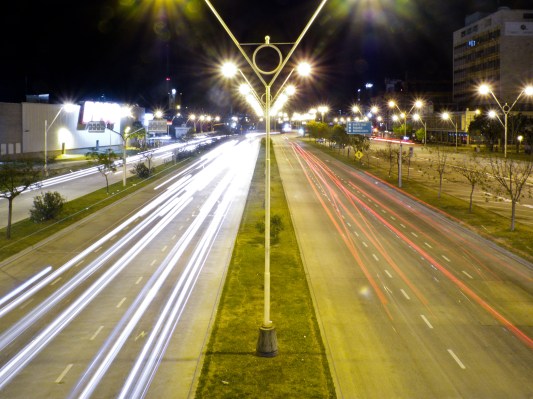GE has a new smart street light in early production, and it hopes that over time, cities and third-party developers will begin to take advantage of the platform to build smart city apps.
The light itself is a super-efficient LED that could last up to 20 years. Where it gets interesting is that GE is including a sensor pack with each bulb with capabilities such as video, light and weather sensors, and giving cities and developers access to its Predix Internet of Things software development platform to build applications based on the data the sensors generate.
As Bill Ruh, VP and global technology director at GE points out, the lighting division is one of GE’s oldest businesses, but the company recognizes the shifting market, and it wants to capitalize on the changing mindset with smarter and more efficient lighting technology.
There are currently two test cities using this lighting today: San Diego and Jacksonville.
Shedding Light On A Problem
“It used to be about generating and wattage a visibility, but today’s product has the potential to be much more,” he explained. “[The light pole] has power and networking and adding sensors, you can now do things with these lights everywhere.”
This means, cities can potentially take advantage of the data being generated by the sensors, and using the GE Predix platform, begin building applications for public safety, transportation, intelligent digital signs and the environment.
The cost of traditional lighting has been a drain on cities and towns and can often account for up to 40 percent of a municipality’s electric bill, Ruh said. This could explain why many cities and towns looking for ways to cut budgets have actually been turning off street lights over the last decade. He claims the new smart street lights can save 50-70 percent on electricity over standard bulbs, and with that savings the new lights can pay for themselves in around 5 years.
Part of that efficiency is gained from LED lighting technology, but it also benefits from being intelligent to run more effectively. From a pure lighting perspective, a smart light can use sensors to brighten or dim as needed or even turn itself on or off, depending on conditions like traffic, weather and so forth.
Making Sensors Of It All
What really separates these lights from the run-of-the-mill light bulb is the pack of sensors that GE provides with each one. These could be weather sensors or a video camera that can see traffic, parking violations and so forth.
As an example, the video sensor generates visual data to apply to any application, Rue said. You could count cars to plan transportation or use video for public safety purposes.
“We essentially provide data from sensors for developers who want to build applications for the city. The cost savings and applications depend on how you use them,” Ruh explained.
If you’re wondering about the privacy implications of a video camera on every light pole, Ruh says it’s up to each city to set policies around the data collected by the sensors and how it can be used. He adds that citizens should have a say in that policy.
There are many companies offering individual applications for cities such as smart metering and video technology, according to Ruh, but where he believes GE separates from these offerings is by providing a more complete platform to build these applications in a single place.
He also understands many cities already use streetlights as a platform to power digital signs such as the ones you see over highways, making announcements about road closings or encouraging you not to text and drive. With GE’s system, cities can still tap into the same power and networking, but they can also communicate with the Predix cloud and generate content based on conditions (such as an impending snowstorm or a water main break).
Rolling With The Changes
GE also makes power plants, wind turbines and other equipment to generate electricity, so there has to be an inherent tension inside the company when it comes to creating highly efficient light bulbs that generate much less electricity. Ruh admits there are heated internal debates, but the company recognizes that it needs to react to the market, and not simply protect existing businesses.
There’s also the matter of changing business models. When you only need to replace a light bulb every 15 or 20 years, the company needs to figure out different ways to make money, and Ruh says that’s part of the reason for the sensors and the app platform. If the company can generate recurring revenue from the data it collects or through revenue sharing with third-party developers, he believes it can begin to fill in some of this revenue gap created by selling more efficient bulbs.
But it’s early days for this type of experiment and with just two cities in operation, it still has a long way to go to prove itself as a viable business. You could argue you don’t even need electric-powered lights. Why not just put a small solar panel on each pole and let the light pole generate its own power?
GE is clearly searching for ways to monetize its Predix platform while finding ways to modernize long-standing businesses. Transforming an older company like GE is a huge challenge, and the company is working on a lot of fronts. The smart light is just one attempt.
